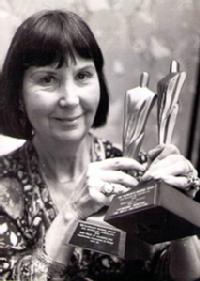- Entry type: Person
- Entry ID: IMP0226
Martin, Catherine Ellen
(1918 – 2009)
- Nationality Australian
- Born 1 January, 1918, London United Kingdom
- Died 31 December, 2009, Perth Western Australia Australia
- Occupation Journalist
Summary
Catherine Martin was a journalist for the West Australian newspaper from 1957, specialising in medical reporting. She was born in the United Kingdom but emigrated to Western Australia and lived there for most of her life.
Details
Catherine Ellen Martin was born in London and migrated, with her husband, a Czech war and Holocaust survivor, to Perth, Australia soon after they were married in 1948. Widowed in 1957, she needed to find work to supporter her three daughters, She embellished her C.V., applied for a job at the West Australian and worked there for the next thirty-odd years. She was responsible for producing one of the most important medical stories in modern Australian history.
In 1978, Martin began investigating the high incidence of death and disease among workers at the Australian Blue Asbestos mine at Wittenoom Gorge. She was able to access a study of the mine workers and their families by Professor Michael Hobbs, a University of Western Australia epidemiologist. This study found a high incidence of illness and death from asbestos-related diseases among the small number of workers in the sample. By 1978, the effects of mesothelioma and other asbestos-related diseases were beginning to show up in the former mine workers. Martin’s front page story for the West Australian won a Walkley award and she produced a series of nine articles highlighting the impact on workers and their families.
On 20 February 1978, the West Australian published Martin’s first article in the series, ‘Blue Asbestos: The Latent Killer’, in which she explained that gas masks manufactured during World War Two were fitted with filters made from merino wool and blue asbestos. British and Canadian authorities had chosen to use the blue asbestos mined at Wittenoom. It was not known at that time that the inhalation of crocidolite – or blue asbestos fibres – could lead to mesothelioma, a cancer that can lie dormant for up to forty years. Since the mine was closed in 1966, Martin found, 28 residents of Wittenoom had already developed the disease. Of former employees of the mine, 82 men had developed the more common form of lung cancer; 17 had silicosis; 59 asbestosis; and 122 silico-asbestosis. On 24 February 1978, Martin published a second article, ‘Sisters await family scourge’, profiling sisters and Wittenoom residents Mrs Shirley Eacott and Mrs Valerie Jones. Their father, Philip McKenna, who worked at the Australian Blue Asbestos mill from the early 1950s, died of asbestosis and silicosis; their mother died of mesothelioma; and Valerie’s husband died of lung disease at the age of 51. Martin profiled a number of other Wittenoom residents and former miners affected by the disease.
On 1 March 1978, Martin published again, noting that the State Government Insurance Office was receiving ten new applications per month for workers’ compensation for disease or death due to having worked in the mining of asbestos, or the production of goods made from it. This was up from ten claims per year, the general rate up until 1977. According to Martin, a man totally incapacitated by asbestos-related disease could claim a maximum of $41,000 – or four years’ wages.
By 13 June 1978, Martin was able to report – on the front page of the West Australian – the establishment of a $2 million foundation for asbestos mine cases. CSR Ltd, which operated the mine between 1943 and 1966, set up the foundation to help people affected by asbestos from the Australian Blue Asbestos mine at Wittenoom. Though Martin was noting dissatisfaction with the foundation – ‘Wittenoom fund fails to please all’ – by August, its establishment was something of a breakthrough, and the publicity she gave to the plight of Wittenoom residents can only have hurried the outcome. The Ex-Wittenoom Residents Association was formed to support those seeking assistance.
Catherine Martin was made a Member of the Order of Australia on 12 June 1982 for services to journalism. She had by then won numerous awards for journalism including four Walkley awards, five Arthur Lovekin awards and a number of Australian Medical Association awards. Martin also received the inaugural Gold Walkley.
She died in 2009, in the week that Justice Ian Gzell, in the NSW Supreme Court, found the company James Hardie guilty of misleading conduct and failing to meet its obligations over its handling of asbestos compensation.
Events
-
1975 - 1975
Best Piece of Reporting for the Year – The West Australian WA
Walkley Award (Print) -
1978 - 1978
Best Piece of Reporting for the Year – The West Ausralian WA
Walkley Award (Print) -
1978 - 1978
Gold Award – Best Piece of Journalism, Newspaper, TV or Radio – The West Australian, WA
Walkley Award (Gold Walkley) -
1981 - 1981
Best Feature – Either in a Newspaper or Magazine (Highly Commended) – The West Australian, WA
Walkley Award (Print)
Published resources
- Newspaper Article
-
Site Exhibition
- The Women's Pages: Australian Women and Journalism since 1850, Australian Women's Archives Project, 2008, http://www.womenaustralia.info/exhib/cal/cal-home.html
- Faith, Hope and Charity Australian Women and Imperial Honours: 1901-1989, Australian Women's Archives Project, 2003, http://www.womenaustralia.info/exhib/honours/honours.html
-
Resource
- Trove: Martin, Catherine Ellen (1918-2009), http://nla.gov.au/nla.party-775061